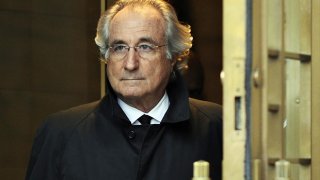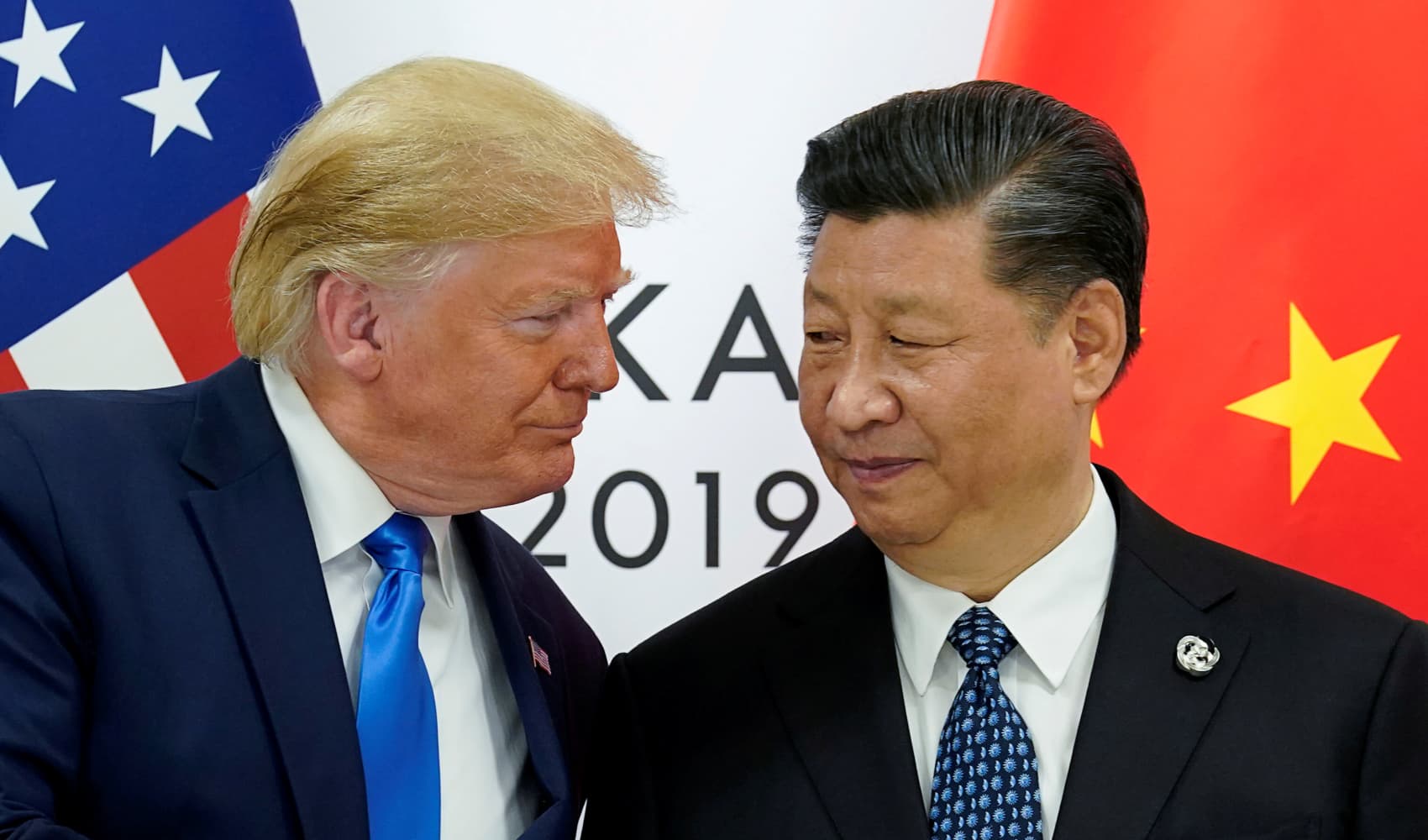
Bernard Madoff leaves U.S. Federal Court after a hearing regarding his bail on Jan. 14, 2009, in New York.
- For years before his death, fraud mastermind Bernie Madoff tried behind the scenes to shape his own legacy.
- In previously undisclosed emails, Madoff falsely claimed he helped recover billions of dollars for his victims and pressured big investors to return their profits.
- Madoff died in prison on Wednesday at age 82.
From the moment he arrived at the federal prison complex in Butner, North Carolina, on July 14, 2009, until his death Wednesday, Bernard Madoff was more than just inmate No. 61727054.
Fellow inmates reportedly sought him out for financial advice. Academics, attorneys and journalists clamored for his insights on the epic fraud he carried out.
Get top local stories in San Diego delivered to you every morning. Sign up for NBC San Diego's News Headlines newsletter.
After decades on Wall Street, Madoff knew a thing of value when he had one. So, in much the same way as he attracted investors to his fraudulent scheme by appearing to be aloof, Madoff was strategically stingy in his responses, parceling them out in what seemed to be a carefully crafted attempt to shape his own legacy.
My attempts to establish contact with Madoff began around the time he pleaded guilty to 11 criminal counts in March 2009. They included multiple letters to him in prison. Finally, on Oct. 20, 2012, he responded.
"Scott, you (are) nothing if not persistent," he wrote.
Money Report
Many of the dozens of emails he sent over the next several years were off the record. That condition expired with his death in prison, two weeks shy of his 83rd birthday. Now, his writings can be revealed.
Market maker
In that initial email, Madoff sought to position himself as an authority on the market system he helped develop, leading to his appointment as non-executive chairman of Nasdaq in 1990.
Never mind that Madoff had done more to undermine investor confidence than perhaps any individual in market history. At the time of our initial correspondence, the financial world was still abuzz with the lack of major criminal prosecutions following the 2008 financial crisis.
"I find it frustrating that over my career I have both chaired and served on numerous committees and boards where some of the very practices that created the events responsible for the mess were discussed in detail, and at some of these same meetings there were the regulators, general councils [sic] and CEOs that now claim they had zero knowledge of what was happening," he wrote.
In another message, on March 22, 2013, Madoff launched into perhaps the most audacious portrayal of his alleged achievements.
"It is not necessary to go into the success and accomplishments of the business that I, together with my family, created," he wrote. "Regardless of the cries and accusations of others, there is enough documentation and history to establish a lasting legacy. A legacy that my family can be proud of in spite of the terrible mistake I made and (am) solely responsible for."
Madoff was always careful to throw in a mention of the guilt he claimed to feel over his fraud.
"Scott, please understand that I have never denied my guilt or failed to state my shame and remorse for the damage I have caused," he wrote on Oct. 23, 2012.
But in that same email, he expressed frustration about how he was portrayed following his previous attempts to tell his story, including in the authoritative book about the scandal, "The Wizard of Lies" by Diana B. Henriques, published in 2011. Madoff complained that despite his extensive cooperation, the book portrayed him as "a villainous poster boy of Wall Street."
The story Madoff really wanted to tell was his claim that he was providing extensive assistance to prosecutors and to court-appointed trustee Irving Picard in recovering assets for the victims. Madoff claimed that "95% of the recovery to date" was the result of his pressuring a handful of big investors to return their profits, otherwise he would expose their "complicity."
They included Florida philanthropist Jeffry Picower, found dead in his swimming pool of a heart attack in 2009. The following year, his widow, Barbara Picower, agreed to a $7.2 billion settlement, which remains the largest single recovery to date.
"From the day of my arrest I have offered both the Gov't and the Trustee my assistance in the recovery of assets," Madoff wrote.
"In the first days I was out on bail, I contacted these parties and made it quite clear that they had the following options. Return the monies which would cover the investment principal of my clients," Madoff wrote on Nov. 19, 2012. "I reminded them that I had numerous written correspondence and fax instructions issued and signed from them and their accountants and employees. I went on to state that I had nothing to lose by giving out this information, having already pleaded guilty and facing a long sentence."
At the time of the settlement, Barbara Picower's attorney said it was motivated not by guilt or any sort of pressure, but because it was the right thing to do.
"She believes in the principle that anyone who receives money from a fraud should return it to the rightful owners," William Zabel said.
Both Picard and federal prosecutors have said that Madoff provided no assistance whatsoever in tracing or recovering assets, and that there is no evidence he contacted his former investors. His plea agreement in 2009 included no provision for his cooperation with the government.
Criminal chronology
Prosecutors and Picard have alleged that Madoff's fraud began as early as the 1970s, but Madoff repeatedly tried to claim that it started much later, as an attempt to sidestep a break in the markets that spun wildly out of control.
"Everything went along fine for years and then we ran into the 1987 market crash," Madoff said in a lengthy email on March 18, 2013. "My U.S. clients, particularly three families, started to panic."
Madoff said he had developed a complex hedging strategy allowing his clients to minimize their tax liabilities in the market runup, but it all began to unravel when clients sought to unwind their positions. He wrote that he managed to navigate the 1987 crash, and as the market rebounded, "more monies started to flow in as word got out that Bernie had a new strategy for hedge funds and high net worth clients."
"Then the market stalled due to the onset of the recession and the Gulf war."
Madoff claimed that is where the fraud began: when he falsely claimed to his clients that he was investing their money in the stock market and earning outsized returns. In fact, the bulk of the money was simply deposited into a JPMorgan Chase bank account.
"The rest is my tragic history of never being able to recover," he wrote.
Investigators have said that Madoff's account, like the trades he claimed to have executed, was pure fiction.
My interactions with Madoff culminated in an extraordinary, two-hour meeting with him in a conference room at the Butner prison in early 2013.
In the meeting, he stuck to his purported timeline of the fraud and his contention that some victims, and the settling banks, were "complicit." (In 2014, JPMorgan Chase agreed to pay $2.6 billion — without admitting wrongdoing — to settle allegations that it turned a blind eye to the fraud.)
Nevertheless, Madoff said he found prison relaxing and that he was catching up on his reading.
"It's like being in the army, only no one is trying to kill you," he said.
Death in disgrace
As the years went on, and Madoff apparently realized that his efforts to shape his own legacy were largely futile, the correspondence from prison began to dwindle.
In 2014, Madoff disclosed that his health was deteriorating, including stage four kidney disease, a condition prison doctors diagnosed as terminal in 2019.
The last email came in July of that year, in response to an inquiry about a notation on the U.S. Bureau of Prisons website that he had recently been transferred to the prison medical center.
"I'm okay," he wrote.






